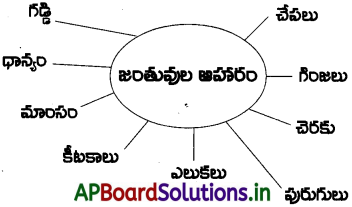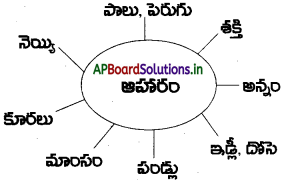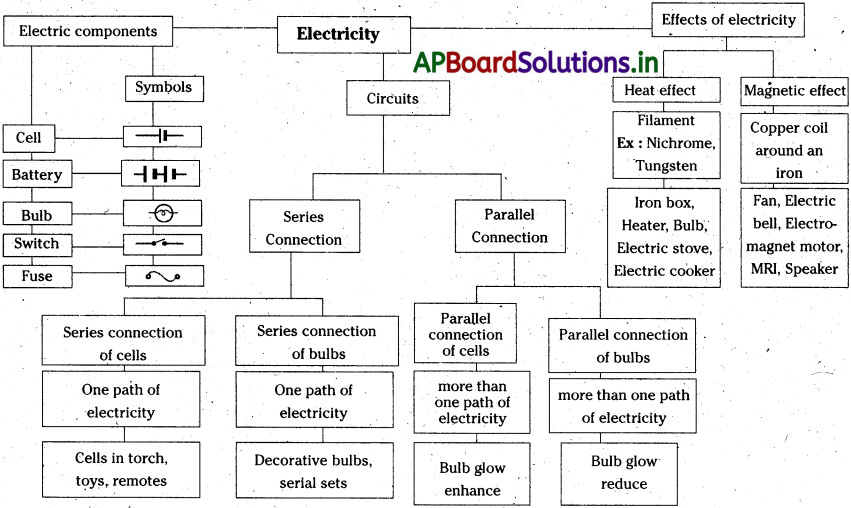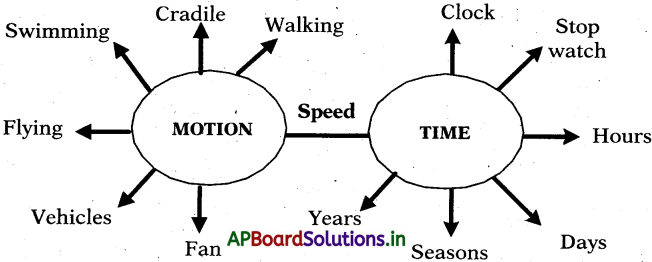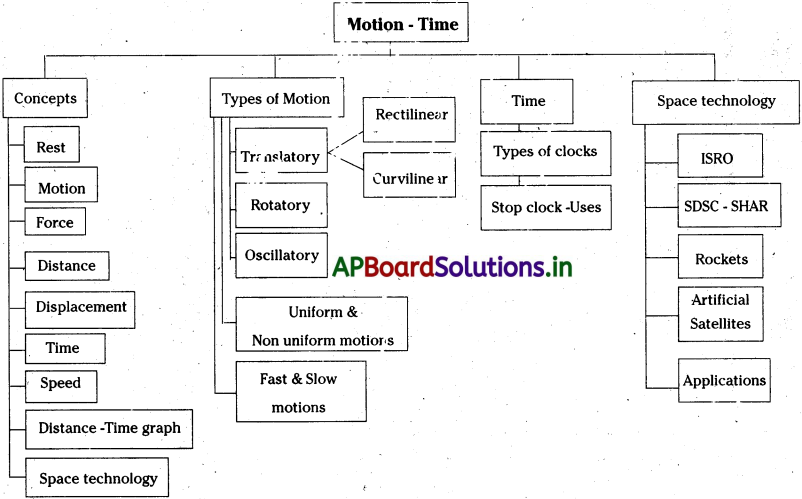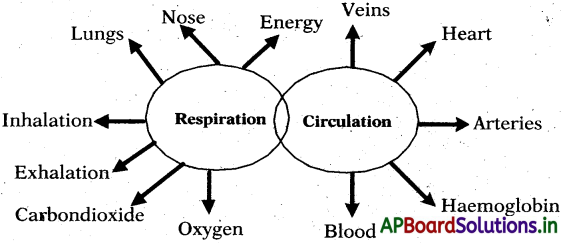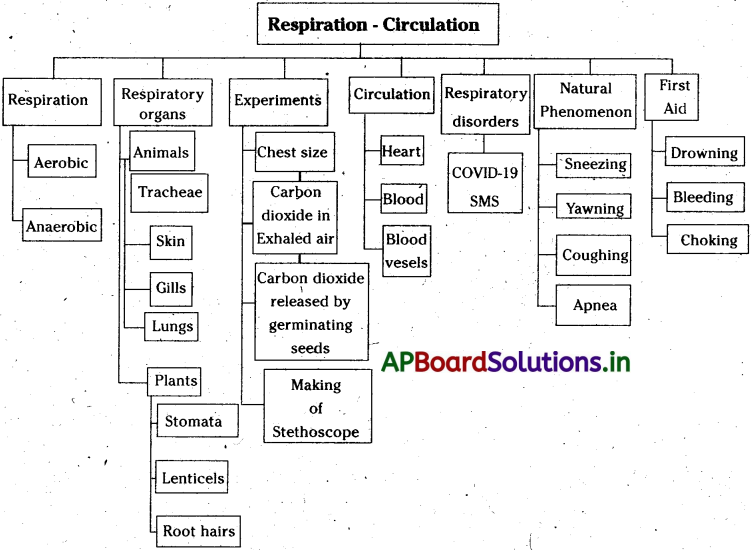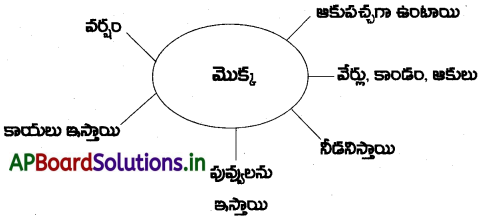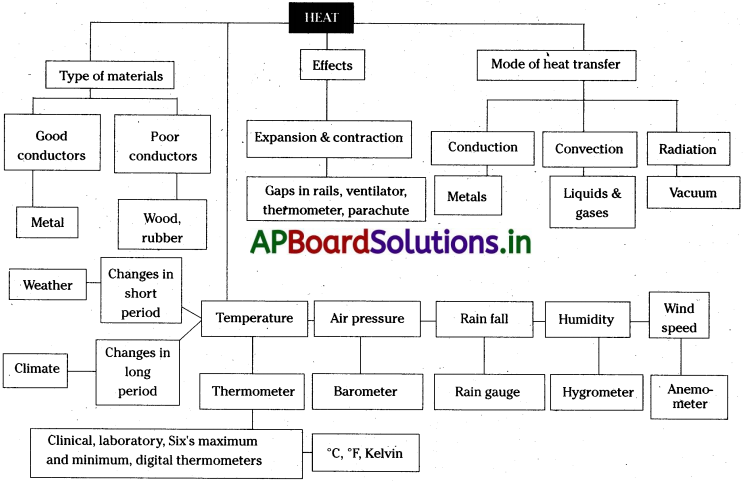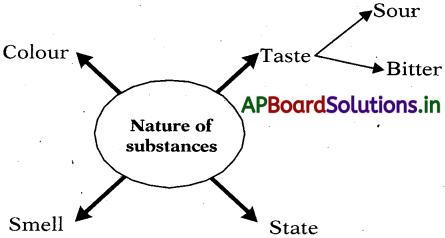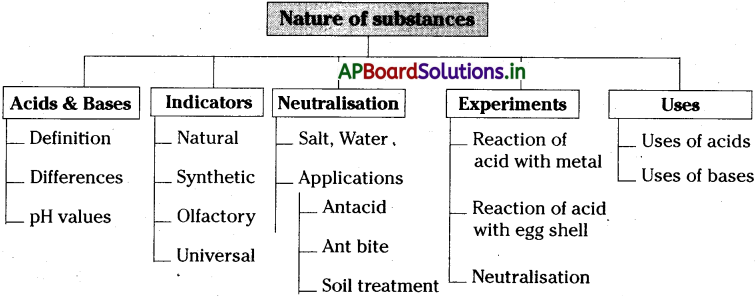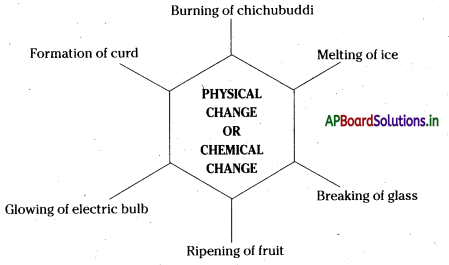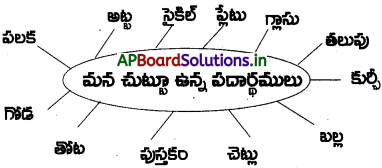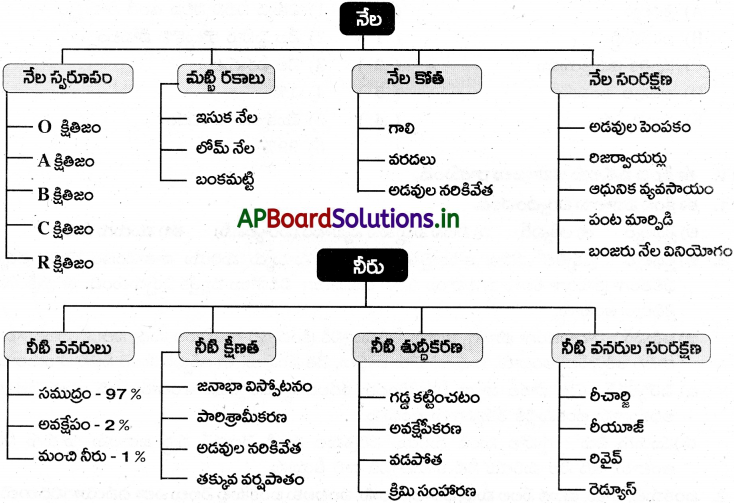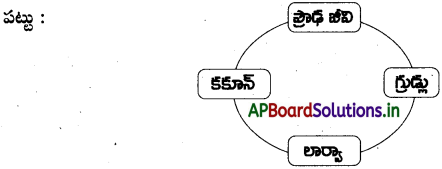Students can go through AP Board 6th Class Science Notes 3rd Lesson జంతువులు to understand and remember the concept easily.
AP Board 6th Class Science Notes 3rd Lesson జంతువులు
→ మన పరిసరాలలో నివసించే వివిధ రకాల జంతువులకు వారి స్వంత ఆహారపు అలవాట్లు ఉన్నాయి.
→ మన పరిసరాలలో ఆహారానికి మొక్కలు మరియు జంతువులు ప్రధాన వనరులు.
→ ప్రతి జంతువుకు ఆహారాన్ని పొందటానికి ప్రత్యేక శైలి ఉంది.
→ కొన్ని జీవులు పీల్చటం, నాకటము, ఏరుకోవటము, నమలటము, చీల్చటము, మింగడం ద్వారా ఆహారాన్ని సేకరిస్తాయి.
→ కొన్ని జంతువులు వేటాడి చంపి చీల్చుకు తింటాయి.
→ ఆహారాన్ని గుర్తించడానికి చాలా జంతువులు విస్తృతమైన జ్ఞానేంద్రియాలను ఉపయోగిస్తాయి. – వాసన, దృష్టి, వినికిడి, రుచి మరియు స్పర్శ ఆధారంగా ఆహారాన్ని సేకరిస్తాయి.
![]()
→ జీవులలో ఒకే రకమైన ఆహారాన్ని తీసుకోవడానికి వివిధ రకాలైన భాగాలను ఉపయోగించవచ్చు.
→ పక్షులు ఆహారాన్ని తినడానికి వివిధ రకాల ముక్కులను కలిగి ఉంటాయి.
→ జలగలు చర్మానికి అతుక్కుని పశువుల మరియు మానవుల రక్తాన్ని పీలుస్తాయి.
→ కప్ప దాని ఆహారాన్ని జిగురుగా ఉండే తన నాలుక ఉపయోగించి పొందుతుంది.
→ జంతువులను వాటి ఆహారం ఆధారంగా మూడు రకాలుగా విభజించారు. అవి శాకాహారులు, మాంసాహారులు మరియు సర్వ ఆహారులు.
→ పదునైన దంతాలు మరియు నాలుకను ఉపయోగించి కుక్కలు ఆహారాన్ని తింటాయి.
→ సింహం, పులి వంటి అడవి జంతువులకు పరిగెత్తడానికి బలమైన కాళ్లు, పట్టుకోవడానికి పదునైన పంజాలు మరియు మాంసాన్ని చీల్చటానికి పదునైన దంతాలు ఉన్నాయి.
→ ఆహార గొలుసు అంటే జంతువుల మధ్య గల ఆహారపు సంబంధాలు.
→ ఆహార గొలుసులో ఉత్పత్తిదారులు, ప్రాథమిక వినియోగదారులు, ద్వితీయ వినియోగదారులు మరియు తృతీయ వినియోగదారులు అని పిలువబడే ఆహార స్థాయిలు ఉంటాయి.
![]()
→ సూర్యరశ్మి నుండి ఆహారాన్ని తయారు చేసుకునే జీవులను ఉత్పత్తిదారులు అంటారు.
→ అన్ని జంతువులు వినియోగదారులే ఎందుకంటే అవి సొంతంగా ఆహారాన్ని తయారు చేసుకోవు.
→ ఆహార గొలుసు జీవుల మధ్య ఆహార సంబంధాలను సూచిస్తుంది. ఇతర జీవులను తినడం ద్వారా జీవులు శక్తిని మరియు పోషకాలను ఎలా పొందుతాయో ఆహార గొలుసు వివరిస్తుంది.
→ ఆహార గొలుసు ప్రకృతిలో విభిన్న జీవులు పరస్పరం ఆధారపడటాన్ని వివరిస్తుంది.
→ ఉత్పత్తిదారులు, వినియోగదారులు మరియు నేల మధ్య పదార్థాల రవాణాలో విచ్ఛిన్నకారులు సహాయపడతాయి.
→ పర్యావరణ వ్యవస్థలోని అనేక ఆహార గొలుసులు ఒకదానితో ఒకటి అనుసంధానించబడి ఆహార జాలకమును ఏర్పరుస్తాయి.
→ చాలా జంతువులు సమూహములుగా నివసిస్తున్నాయి. ఉదా : ఏనుగులు, చీమలు, తేనెటీగలు.
→ చీమల సమూహములో కార్మికులు, సైనికులు, ఆడ మరియు మగ చీమలు ఉంటాయి.
→ ఆహారపు అలవాట్లు : ఒక వ్యక్తి లేదా జంతువు తినే ఆహారం మరియు సేకరించే విధానం వారి ఆహారపు అలవాటు అవుతుంది.
→ శాకాహారులు : మొక్కలను ఆహారంగా తీసుకొనే జంతువులు.
ఉదా : ఆవు, జింక.
→ మాంసాహారులు . : జంతువులను ఆహారంగా తీసుకొనే జంతువులు.
ఉదా : తోడేలు, పులి, సింహం.
→ ఉభయాహారులు : మొక్క మరియు జంతువులను ఆహారంగా తీసుకొనే జీవులు.
ఉదా : కాకి, కోడి, మనిషి.
→ నెమరు వేయడం : మింగిన ఆహారాన్ని నోటిలోకి తిరిగి తెచ్చుకొని తీరుబడిగా నమలటము.
ఉదా : ఆవు, గేదె, ఒంటె.
→ ఆహారపు గొలుసు : ఆహారపు గొలుసు ఒక నిర్దిష్ట ఆవాసంలోని వివిధ జీవుల మధ్య ఆహార సంబంధాన్ని చూపిస్తుంది.
→ ఉత్పత్తిదారులు : తమ ఆహారాన్ని తామే తయారుచేసుకొనే జీవులు.
ఉదా : మొక్కలు.
![]()
→ వినియోగదారులు : ఆహారం కోసం ఇతర జీవులను తినే జీవులను “వినియోగదారులు” అంటారు.
ఉదా : జింక, పులి, సింహం.
→ విచ్ఛిన్నకారులు : చనిపోయిన జీవులను విచ్చిన్నం చేసే జీవులు.
ఉదా : సూక్ష్మ జీవులు (బ్యాక్టీరియా, శిలీంధ్రాలు).
→ ఆహార జాలకము : పరస్పర సంబంధము గల ఆహార గొలుసుల కలయికను ఆహార జాలకము అంటారు.
→ పెంపుడు జంతువులు : మీకు ఆనందాన్ని లేదా సంతోషాన్ని ఇవ్వడానికి మీరు మీ ఇంటిలో పెంచుకొనే జంతువులు.
ఉదా : కుక్క, పిల్లి.
→ ట్రాకింగ్ : ఏదైనా ఒక జీవిని అనుసరించటం లేదా జాడ కనుగొనే ప్రక్రియ.
→ పక్షి ముక్కు : పొడవుగా, దృఢంగా ఉండే పక్షి నోటి భాగం.
→ సరీసృపాలు : వెన్నెముక కలిగి నేలపై పాకే జంతువులు.
ఉదా : పాము, బల్లి.
→ సహజ పారిశుద్ధ్య కార్మికులు : వ్యర్థాలు, చనిపోయిన జీవులను తింటూ పరిసరాలను శుభ్రముగా ఉంచే జీవులు.
ఉదా : కాకి, రాబందులు, శిలీంధ్రాలు, సూక్ష్మజీవులు.
→ వన్య జీవులు : అడవి జంతువులు. ఇవి మచ్చిక చేసుకోని జంతువులు, స్వతంత్రంగా జీవిస్తాయి.
ఉదా : సింహం, తోడేలు మొ||నవి.
→ పెంపకం : జీవుల అవసరాలను తీర్చుతూ శ్రద్ధ వహించటాన్ని పెంపకం అంటారు.
→ పగటి సంచారులు : ప్రధానంగా పగటిపూట చురుకుగా ఉండే జీవులు. ఉదా: ఆవు, గొర్రె, మేక, కోడి, మనిషి.
→ నిశాచరులు : ప్రధానంగా రాత్రి సమయంలో చురుకుగా ఉండే జీవులు.
ఉదా : గుడ్లగూబ, గబ్బిలము, బల్లి.
→ పురుగుమందులు : పురుగుమందులు అనేవి రసాయన లేదా ఇతర విష పదార్థాలు. ఇవి తెగులును చంపడానికి లేదా నిరోధించడానికి ఉపయోగిస్తారు.
ఉదా : గ్లైసిల్.
→ కీటక నాశకాలు : కీటకాలను చంపడానికి ఉపయోగించే పదార్థాలు.
ఉదా : మలాథియాన్, పైరెత్రమ్.
→ సమూహము : ఒకే రకమైన జీవులు కలిసి జీవించడం లేదా కలిసి పెరగడం.
→ ప్రాథమిక వినియోగదారులు : ఆహారము కోసం ఉత్పత్తిదారులపై ఆధారపడే జీవులు.
ఉదా : జింక, ఆవు, మేక.
→ ద్వితీయ వినియోగదారులు : ఆహారము కోసం ప్రాథమిక వినియోగదారులపై ఆధారపడే జీవులు.
ఉదా : కోడి, తోడేలు, నక్క, చేప.
→ తృతీయ వినియోగదారులు : ఆహారము కోసం ద్వితీయ వినియోగదారులపై ఆధారపడే జీవులు.
ఉదా : పులి, సింహం.
→ నీటి స్కేటర్ : నీటి ఉపరితలంపై తేలియాడే చిన్న కీటకము.
→ తెగులు : మొక్కలకు కలిగే అనారోగ్య స్థితి.
![]()
→ తేనె : పువ్వులలో స్రవించే చక్కెర ద్రవం.
→ వేట : ఆహారం కోసం ఇతర జంతువులను వెంబడించి చంపడం.
ఉదా : పులి, సింహం.
→ ఆవరణ వ్యవస్థ : జీవులు నివసించే పరిసర ప్రాంతం.
→ అఫిడ్స్ : మొక్కల రసాలను పీల్చే కీటకాలు.
